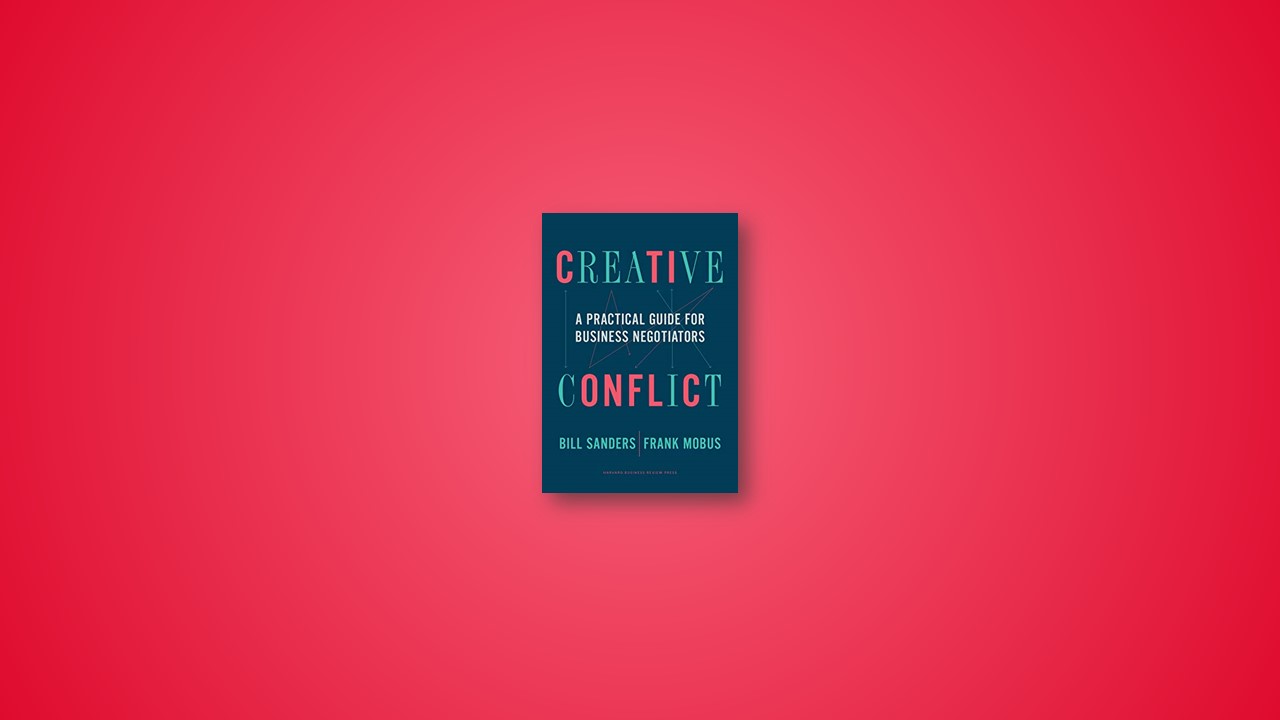Negotiating a New Era
The essence of negotiation is in our differences. Value derives from the gap between two parties’ positions and from their overlapping assets and needs. Creative negotiators steer away from antagonistic conflict and its mind-numbing side effects, anger and fear. They tack into creative conflict, a sea of mutual tradeoffs and thoughtful compromise that gives birth to something new and better.
Win-win is a myth. No matter how harmonious a negotiation may seem on the surface, the competition never completely disappears. A more fitting term might be “Better for Both.” How much better for one party or the other will hinge on the relative skill of the negotiators.
Negotiating can’t be reduced to one-size-fits-all. A haggle at a Shanghai bazaar demands a very different skill set—and mindset—than dealing with a sole-source supplier in Chicago or Berlin. We’ll look at those differences through the lens of the Mobus Negotiating Continuum and its three modes: bargaining, creative dealmaking, and relationship building.
The Mobus Negotiating Continuum
All negotiations are not the same. Depending on the relationship between buyer and seller and the nature of their business, they fall into one of three modes. Each of them involves distinctive tactics, strategies, skill sets, and mindsets. The further to the right we move on the Mobus Negotiating Continuum, the greater a deal’s creative potential.
Bargaining is a zero-sum contest to capture value, an arena where competition outweighs cooperation. Bargainers gain an edge by probing the other side’s flexibility and better defining their own objective needs.
Creative dealmaking surfaces added value. It looks to expand deals via exchanges of complementary concessions, matching each party’s assets with the other’s needs. Competition and cooperation are more or less in equilibrium.
Relationship building optimizes value over the long haul. In its apex expression, a long-term strategic alliance, each side essentially negotiates for the other in light of their common interest. While cooperation overrides competition, contending perspectives keep both sides honest and point them to expanded opportunities.
Overcoming Our Fears
In zero-sum bargaining, conflict is unavoidable. The trick is to avoid antagonistic conflict that overwhelms the creative quest for a more profitable deal.
The most adversarial negotiations contain a cooperative element. It helps to keep in mind that both sides have more to gain by hashing out their differences than by killing the process.
With rare exceptions, there’s no such thing as a firm or fixed price or position. “Take it or leave it” is a tactic, no more and no less.
Successful bargainers recognize and disarm their fears—of failure, of losing, of being wrong, of appearing greedy.
The other side needs you as much as you need them or they wouldn’t be talking to you in the first place.
When a negotiation gets stuck and your counterpart seems immovable, don’t presume you’re at an impasse. They may simply need more acceptance time to come around to your point of view.
Bargaining Strategies
In the bargaining mode, the prime strategy is leverage building. Creative bargainers leverage time, authority, legitimacy, their willingness to risk deadlock, and the other side’s commitment to the deal. And they persist in the face of resistance.
Discovery tests the other side’s limits and flexibility. You’re out to determine which side comes into the negotiation with more power. But whatever the power balance, a friendly conversation can reveal the other party’s needs and even lead to unexpected concessions.
Target-setting is a three-part exercise: your anchor, your aspirational starting point; your target, a reasonable estimate for where you think you’ll land; and your reservation price, the point where you’d be willing to walk away from the deal.
Concessions are double-edged. They can move you closer to a deal or further away from one. Creative negotiators concede slowly, calmly, and in small increments. They agree to split the difference only when it works in their favor.
A good price doesn’t necessarily equate to a good deal. By identifying issues beyond price and exploring what the other side really needs, creative bargainers can increase their net profits.
Bargaining Tactics
Like poker, bargaining—and especially price haggling—contains an element of gamesmanship and misdirection. But beware of out-and-out deceptions that might undermine your future dealings or business reputation.
Take-it-or-leave-it (TIOLI) is rarely a face-value ultimatum and more often a ploy to build leverage. It works best from a strong power position, and it is usually more effective for buyers (who have more options) than for sellers.
A buyer’s demand for a best and final offer (BAFO) can squeeze a seller to close the price gap before the real negotiating even begins. Sellers can deflect a BAFO by preserving room to negotiate and adding points of ambiguity that require a more nuanced discussion.
Tactical deadlock is the ultimate power play, the best way to test the other party’s flexibility and resolve—if you can afford to take the risk of losing the deal.
Be careful and stinting in what you reveal at the bargaining table. An awkward silence can be tactically advantageous. Let the other side blurt out spontaneous disclosures or unplanned concessions while you follow your script and adhere to market norms.
As a negotiation wraps up, beware of nibblers who ask for small, last-minute concessions. You always have the option to grant them or not—or to ask for something in return.
Before agreeing to a concession, translate percentages and other metrics into real dollars. Make sure you know exactly what you’ll be giving up.
Moving around the Table
In creative dealmaking, the two parties find reciprocal tradeoffs to expand the deal—and often to forge a new ZOPA where none seemed to exist.
By focusing on solutions rather than points of division, the continuum’s middle mode expands negotiating space, reduces tension, and nurtures creative conflict.
Mutual gain synergies contain the power to disrupt whole industries.
Creative dealmakers stand ready to trust the other side, as warranted, but remain vigilant in protecting their own interests.
No is the most indispensable word in negotiating—not to shut down the process but to keep it going in pursuit of a better, more creative deal.
Win-win is a myth. It ignores the reality that the two sides are still competing for the larger share of any added value, even in a deal that’s better for both sides.
Creative Dealmaking: Strategies and Tactics
Once bargaining hits a wall, creative dealmaking can lead to a better-for-both solution by matching one side’s assets with the other’s needs.
The primary strategy in this mode is value mapping, which surfaces subtle, hidden assets and reveals mutual gain tradeoffs.
As more information is shared in discovery, both sides gain insights into the other’s needs—and how to craft a value proposition that can meet them.
Ask questions, and lots of them. It’s the best way to expand our knowledge base and to collaboratively find the problem that needs to be solved.
Even when you fully intend to give something up, do it slowly and reluctantly. By making the other party work for the concession, you’ll increase its subjective value. You’ll also incentivize them to generate more profitable solutions.
What the other side wants is not the same as what they need. Set limits on the first while doing all you can to satisfy the second.
The quid pro quo is the essence of creative dealmaking. Before making a no-strings-attached concession, consider how the other side might be able to reciprocate. By enriching the creative process, quid pro quos add value to the outcome.
Joining Forces
Relationship building is the preferred mode for any negotiation involving repetition and complexity. The apex relationship, with the most potential for expanding the value pie, is a long-term strategic alliance.
At this point in the continuum, you’re negotiating for the other side’s interests as well as for your own.
While cooperation is primary, the two parties still compete in pursuit of total value optimization, where assets and needs are matched for maximum benefits over time.
A fair outcome isn’t always an even split. The relationship’s future outweighs the short-term bottom line.
Positive leverage, typically in the form of delight factors, is appropriate in any long-term relationship where you can rely on the other side.
Otherish givers trust their partners and set a generous tone, but remain watchful for backsliding.
Don’t fall in love. No business relationship lasts forever. When an alliance no longer works for both parties, it’s time to find the door.
Team Negotiations
Winning negotiating teams share three characteristics: diversity of opinion, decentralization, and a culture of autonomy and free dissent.
Before engaging the other side, internal negotiations are a must for clarifying roles and laying out the team strategy.
Effective team leaders assert their own positions while creating a safe space for contrary views. When a better idea emerges, they don’t hesitate to change course.
To prepare for the other side’s attacks, appoint a devil’s advocate to poke holes in the team’s approach.
As the team moves from planning to the actual negotiation, make sure that everyone is on the same page. If your team seems divided at the table, the other side will conquer.
Internal Negotiations
In internal negotiations, relationships are always primary. The goal is a long-term alliance. If your internal partner proves untrustworthy, you can pull back to a more skeptical posture later on.
Your colleagues’ buy-in is essential to success at the bargaining table. It’s wise to build rapport with stakeholders before a negotiating crunch, and to get their input before handing them a fait accompli.
Internal discovery will clarify your stakeholders’ needs—and possibly reveal an important factor you’d overlooked.
Never drift into an internal negotiation. Plan for it as you would for an external one. Determine your leverage. Set a starting anchor, a fallback, and a walkaway point. In the spirit of matching, consider how the stakeholder might reciprocate for any concessions you make.


